Matcha
Matcha Vs Green Tea: Benefits & Differences
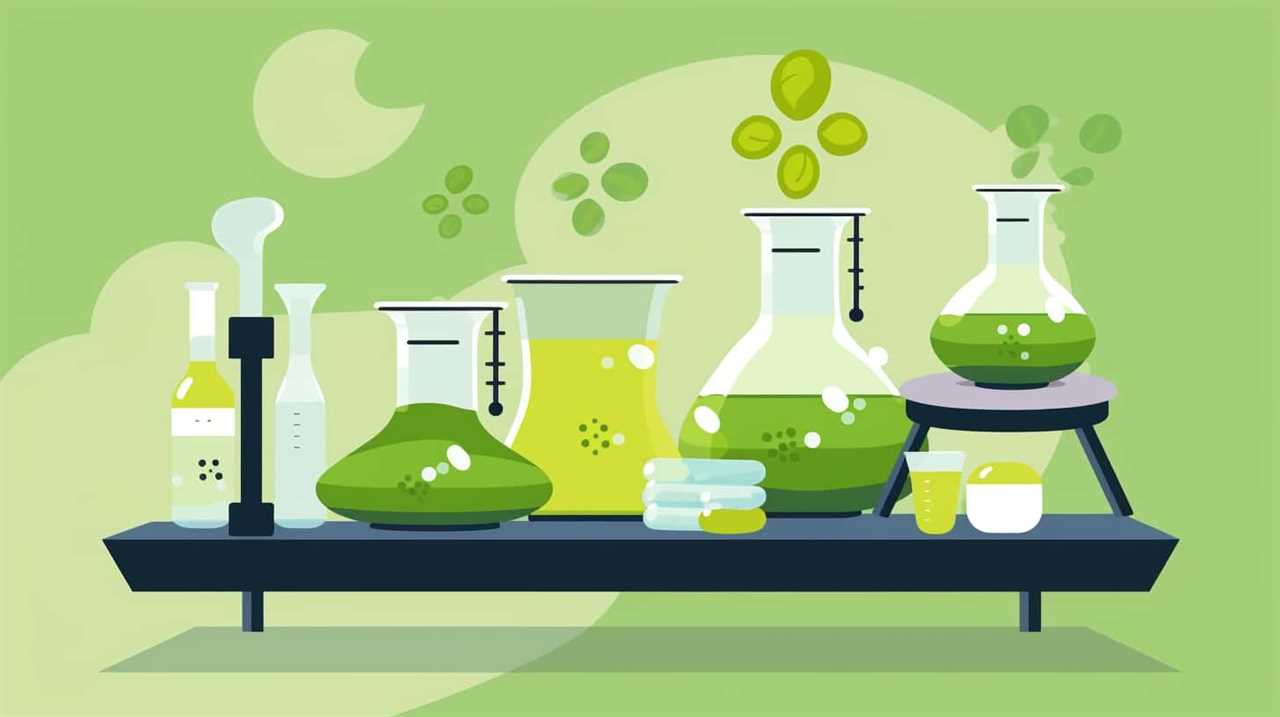
When it comes to tea, there’s one debate that has us tea enthusiasts buzzing: matcha versus green tea.
Imagine sipping on a velvety, vibrant green matcha latte or enjoying a soothing cup of steaming green tea. Both have their unique qualities, and as connoisseurs seeking mastery, we crave a deep understanding of their differences.
From the rich history and origins to the meticulous production process, there is much to explore. We’ll delve into the flavor profiles, nutritional content, caffeine levels, health benefits, culinary uses, and even the price comparison.
Ultimately, it all boils down to personal preference. So grab your teacup and join us on this journey to unravel the intricacies of matcha versus green tea.

Key Takeaways
- Matcha and green tea have their origins in ancient China and were introduced to Japan in the 12th century.
- Matcha is made by steaming the leaves and grinding them into a fine powder, while green tea is pan-fired and consumed in loose leaf or tea bag form.
- Shade-grown leaves used in matcha production offer enhanced flavor and aroma, as well as higher levels of L-theanine for a calming effect.
- Matcha has a naturally sweet taste with a pronounced grassy flavor and a distinct vegetal fragrance, while green tea can lean towards bitterness with a more subtle, earthy aroma.
History and Origins
One of the first things we need to understand about the history and origins of matcha and green tea is that they both have their roots in ancient China. Matcha, a powdered form of green tea, was first introduced to Japan in the 12th century by Buddhist monks who’d learned about its production techniques during their travels to China.
The cultural significance of matcha and green tea can’t be overstated. In Japan, matcha became an integral part of the tea ceremony, symbolizing harmony, respect, and tranquility. Similarly, green tea has been a staple in Chinese culture for centuries, valued for its health benefits and refreshing taste.
With this understanding of their shared history and cultural importance, let’s now delve into the production process.
Production Process
When it comes to the production process, matcha and green tea differ in several key ways.

Firstly, matcha is made by steaming the leaves, while green tea is typically pan-fired. This difference in processing methods gives matcha a distinct flavor and vibrant green color.
Additionally, matcha is made from shade-grown tea leaves, which helps to enhance its unique taste and increase the chlorophyll content.
Finally, matcha is finely ground into a powder, whereas green tea is usually consumed in loose leaf or tea bag form.
These differences in production methods contribute to the distinct qualities and characteristics of matcha and green tea.
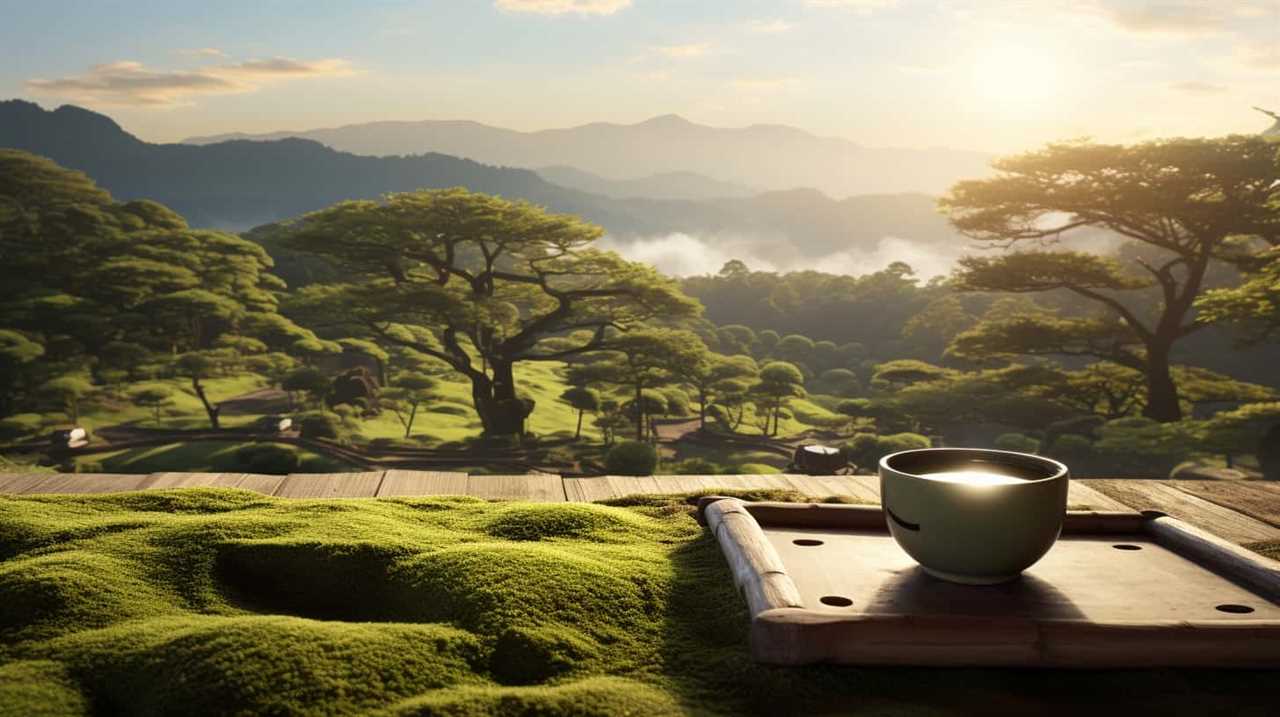
Steaming Vs Pan-Firing
We prefer the steaming production process over pan-firing for both matcha and green tea due to its ability to preserve the natural flavors and antioxidants.
Steaming benefits the tea leaves by maintaining their vibrant green color and enhancing their nutritional value. During the steaming process, the leaves are quickly heated, which helps to halt oxidation and preserve the tea’s delicate flavors. This method also helps to retain the tea’s high levels of antioxidants, such as catechins and polyphenols, which are known for their numerous health benefits.
On the other hand, pan firing techniques involve applying heat to the leaves in a pan, which can result in the loss of some of the tea’s natural compounds and flavors.
As we transition to the next section on shade-grown leaves, it’s important to note that the steaming process is often used for these types of teas to further enhance their unique characteristics.
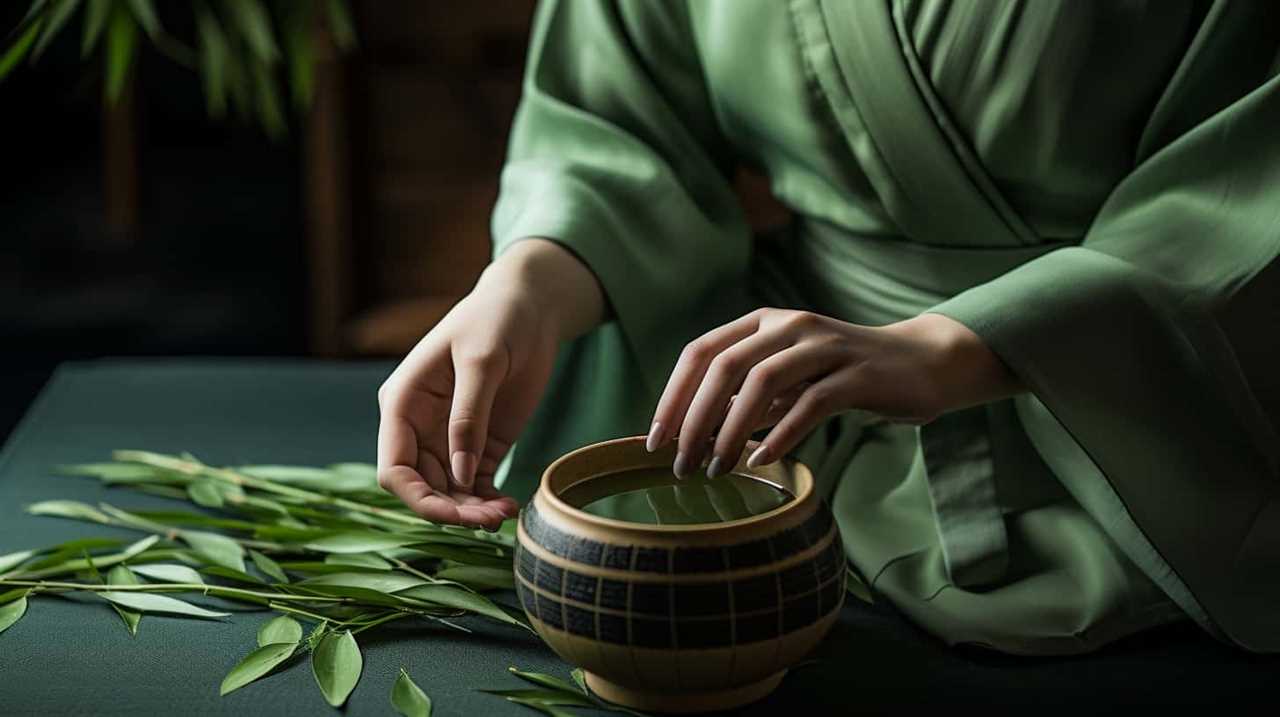
Shade-Grown Leaves
To begin exploring the production process of shade-grown leaves, let’s delve into the fascinating world of cultivating tea plants under carefully controlled levels of shade. Shade-grown leaves offer numerous benefits and hold great cultural significance. Here is a glimpse into this intriguing process:
- Enhanced flavor and aroma: The shade slows down the growth of the tea leaves, resulting in a sweeter and more flavorful brew.
- Increased chlorophyll content: The reduced exposure to sunlight causes the tea leaves to produce more chlorophyll, giving them a vibrant green color.
- Higher levels of L-theanine: Shade-grown leaves have elevated levels of this amino acid, which contributes to a calming and focused state of mind.
- Reduced bitterness and astringency: The shading process helps to decrease the levels of catechins, resulting in a smoother and less bitter taste.
- Traditional Japanese practice: Shade-grown leaves are deeply rooted in Japanese tea culture, symbolizing the artistry and meticulousness of tea production.
Now that we’ve explored the cultivation of shade-grown leaves, let’s move on to the next step in the production process: grinding the leaves into a fine powder.
Grinding Into Powder
After exploring the cultivation of shade-grown leaves, we now transition to the next step in the production process: grinding the leaves into a fine powder. This crucial step requires skilled artisans who employ various grinding techniques to produce the desired texture and quality.
Traditionally, granite stone mills were used to grind the leaves slowly and meticulously, preserving the delicate flavors and nutrients.
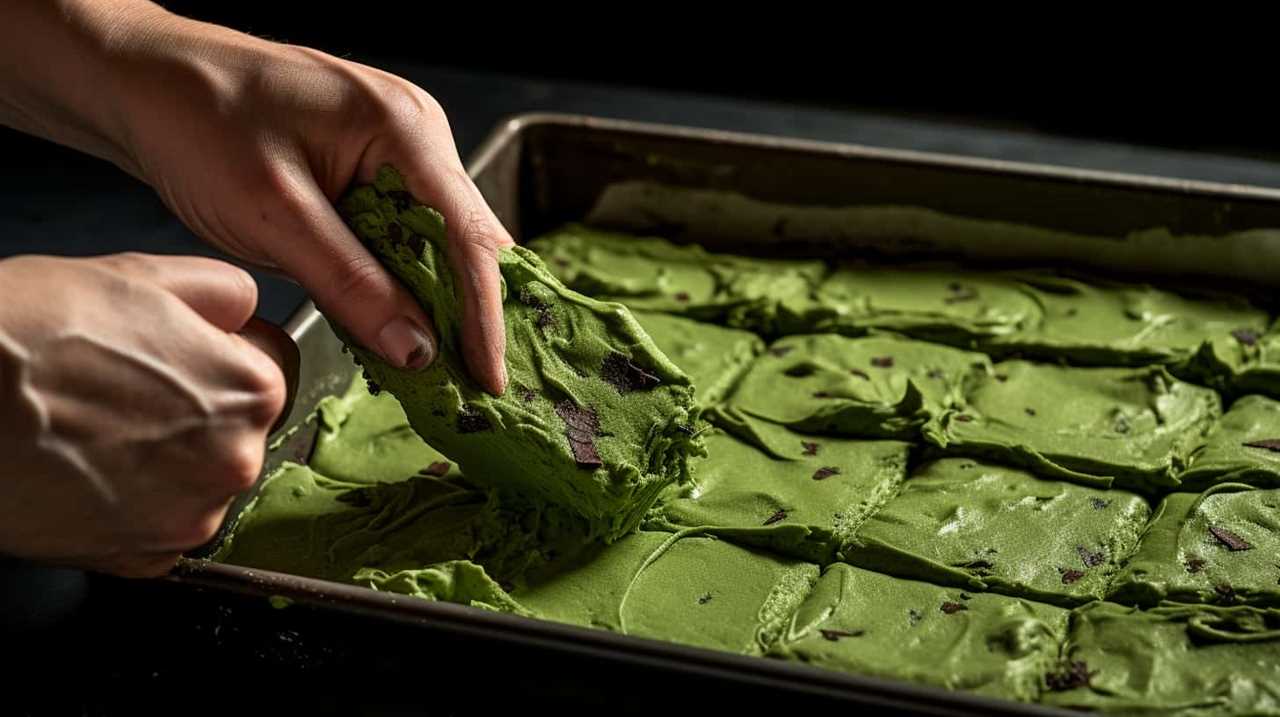
In modern times, high-quality matcha is often produced using ceramic or stainless steel mills, which can quickly grind the leaves into a fine powder.
The resulting vibrant green powder is then used in the ceremonial preparation of matcha tea. The grinding process not only transforms the leaves but also intensifies the flavor and aroma, setting the stage for the subsequent section where we’ll delve into the unique flavor profile of matcha.
Flavor Profile
When comparing matcha and green tea, the flavor profile is an important aspect to consider.
The first point of distinction is the contrast between the sweet and bitter notes in each. Matcha tends to have a naturally sweet taste, while green tea can lean towards a more bitter flavor.
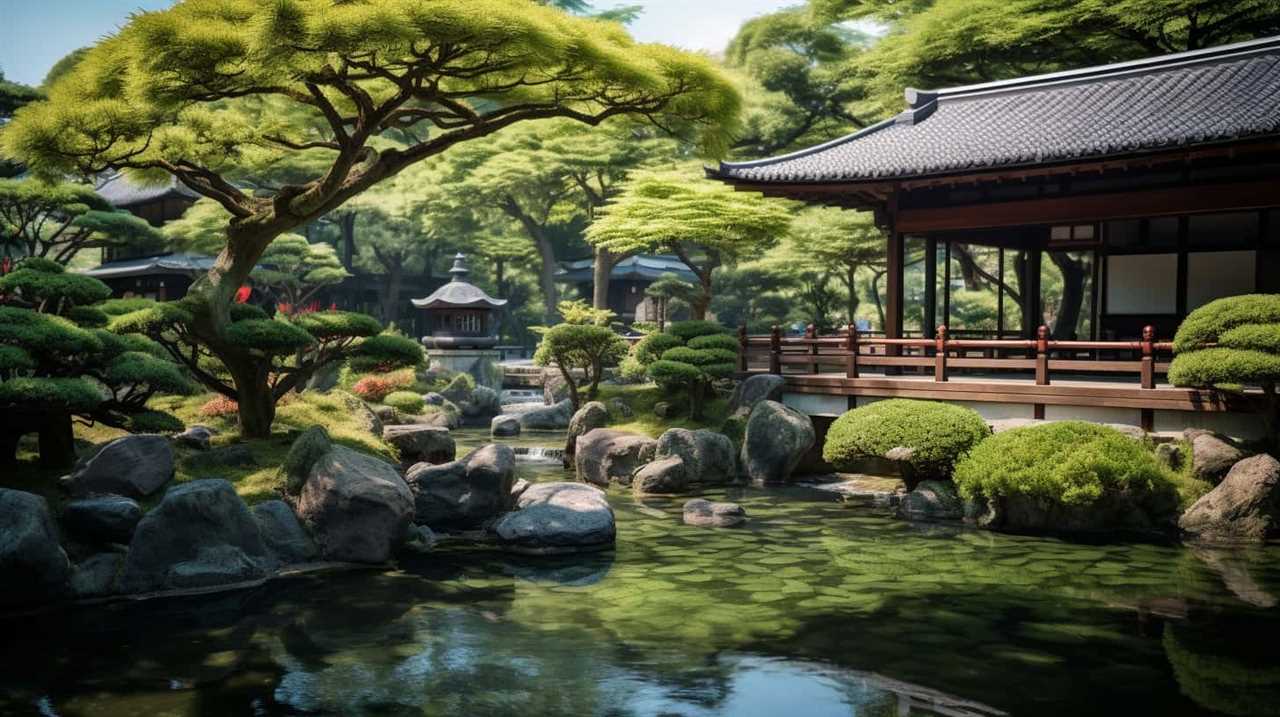
Another aspect to consider is the grassiness level, with matcha having a more pronounced grassy taste compared to green tea.
Lastly, both beverages showcase their unique aromatic notes, with matcha being known for its distinct vegetal fragrance and green tea offering a more subtle, earthy aroma.
Sweet Vs. Bitter
The flavor profiles of matcha and green tea differ in terms of sweetness and bitterness. When it comes to sweetness preference, matcha offers a unique and pleasant taste. It has a naturally sweet and creamy flavor, which is often described as umami-like. On the other hand, green tea tends to have a more subtle sweetness, with a slightly grassy or vegetal undertone.
In terms of bitterness tolerance, matcha can be more intense in bitterness due to its concentrated form. However, many people find the bitterness of matcha to be balanced and enjoyable. Green tea, on the other hand, can vary in bitterness depending on the variety and brewing method. Some green teas have a milder bitterness, while others can be more robust.
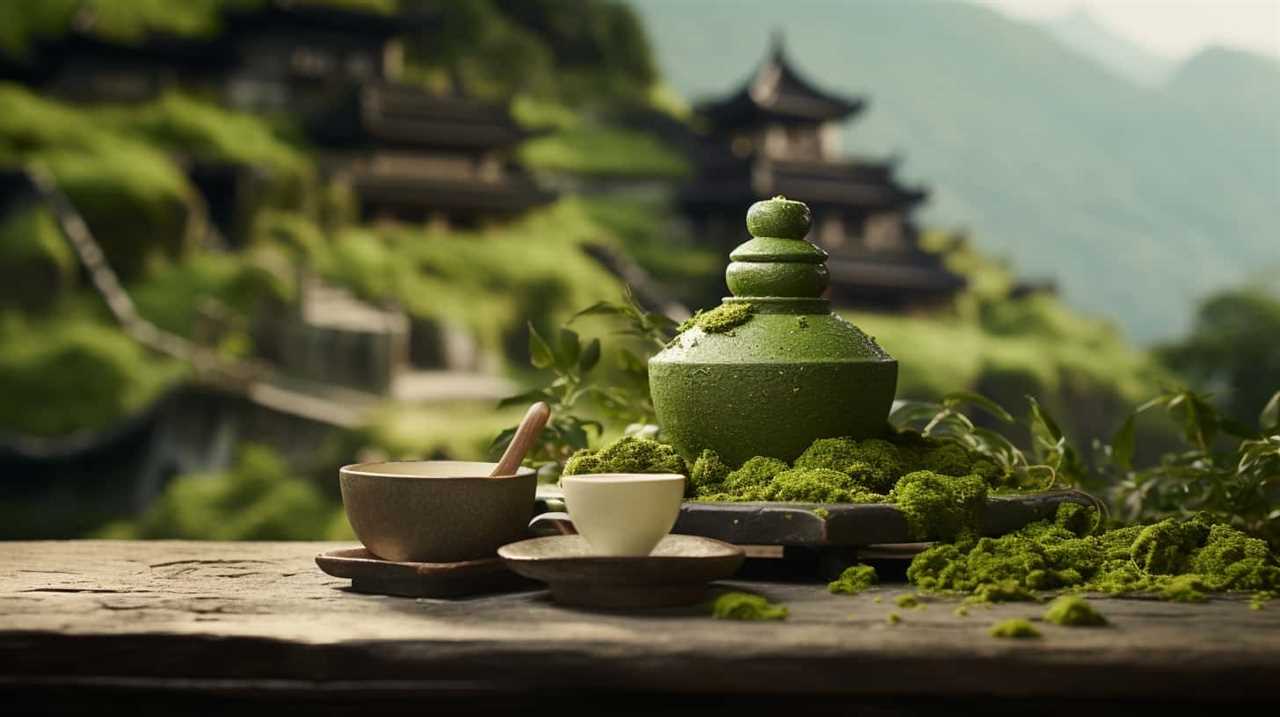
Overall, matcha and green tea offer distinct flavor profiles in terms of sweetness and bitterness.
- Matcha has a naturally sweet and creamy flavor.
- Green tea has a subtle sweetness with a grassy undertone.
- Matcha can be more intense in bitterness.
- Green tea’s bitterness varies depending on the variety and brewing method.
- Many people find the bitterness of matcha to be balanced and enjoyable.
Grassiness Level
Let’s explore the grassiness level, which is an important aspect of the flavor profile when comparing matcha and green tea. The grassiness level refers to the taste and aroma that resembles freshly cut grass. It can vary from subtle to strong, depending on the type of tea and the brewing techniques used.
To better understand the grassiness level, let’s compare matcha and green tea in terms of sweetness level and brewing techniques. Below is a table that outlines these factors:
| Grassiness Level | Sweetness Level | Brewing Techniques | |
|---|---|---|---|
| Matcha | Medium | Low | Whisking and frothing |
| Green Tea | High | Medium | Steeping and brewing |
As you can see, matcha has a slightly lower grassiness level compared to green tea. This is because matcha is made from shade-grown tea leaves, which reduces the grassy taste. On the other hand, green tea, especially sencha, is known for its strong grassy flavor.
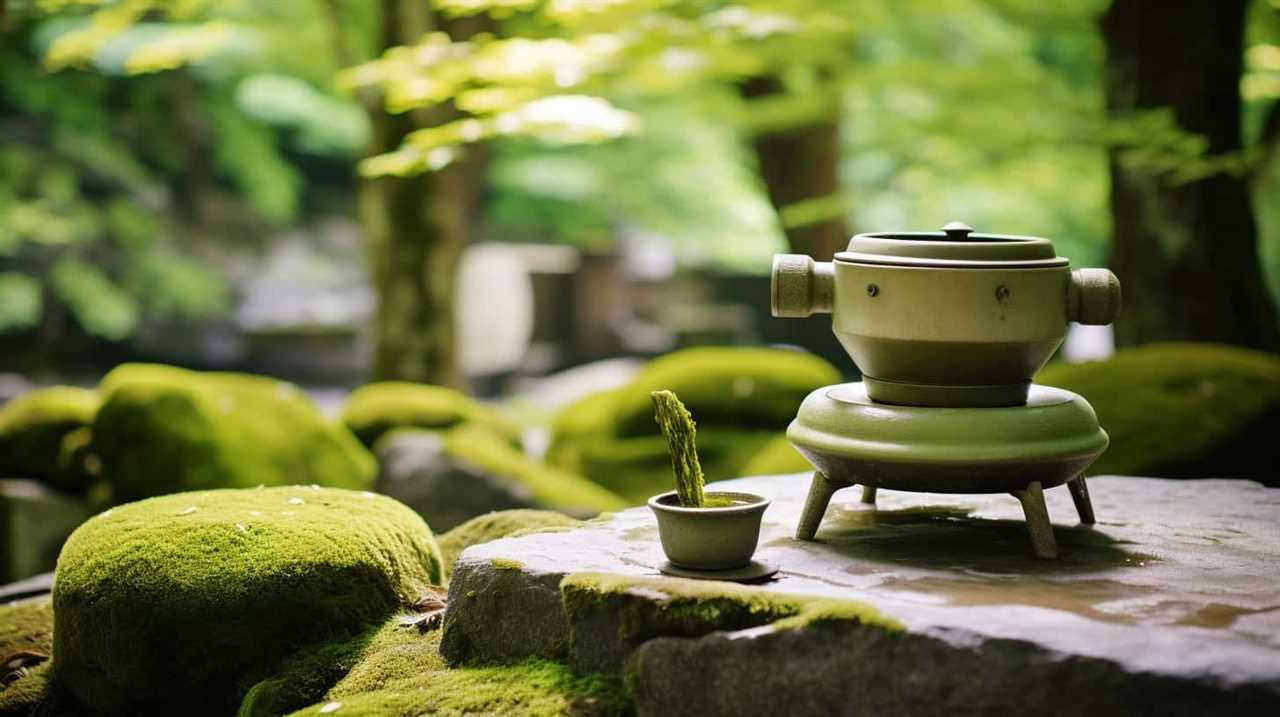
When it comes to sweetness level, matcha tends to be less sweet than green tea. This is because matcha is made from the entire tea leaf, which contains more vegetal and bitter notes. Green tea, on the other hand, is made from the leaves, resulting in a slightly sweeter taste.
In terms of brewing techniques, matcha is whisked and frothed using a bamboo whisk, creating a creamy and smooth texture. Green tea, on the other hand, is steeped or brewed like regular tea, allowing the flavors to develop gradually.
Understanding the grassiness level can help you choose between matcha and green tea based on your preferences. Whether you enjoy a stronger grassy taste or prefer a milder flavor with a hint of sweetness, both matcha and green tea offer unique and delightful experiences.
Aromatic Notes
Now, let’s delve into the aromatic notes of matcha and green tea.

When it comes to flavor comparison, matcha offers a rich and vegetal taste with a hint of sweetness. On the other hand, green tea has a more delicate and grassy flavor profile, with subtle floral undertones.
The brewing techniques also play a significant role in enhancing the aromatic notes. For matcha, the leaves are ground into a fine powder and whisked with hot water, resulting in a frothy and full-bodied beverage.
Green tea, on the other hand, is brewed by steeping the leaves in hot water for a shorter duration, which brings out the fresh and vibrant aromas.
Whether you prefer the boldness of matcha or the subtle nuances of green tea, both options offer a delightful sensory experience.

Nutritional Content
In our comparison between matcha and green tea, let’s explore their nutritional content.
Both matcha and green tea are known for their numerous health benefits. They’re rich in antioxidants, which help protect the body against free radicals and reduce the risk of chronic diseases.
Matcha is particularly revered for its high concentration of catechins, a type of antioxidant that’s found in much higher quantities compared to green tea. Additionally, matcha is packed with vitamins and minerals, including vitamins A, C, and E, as well as potassium and iron.
When it comes to taste, matcha has a unique, earthy flavor that’s bold and slightly bitter, while green tea has a more subtle, grassy taste.
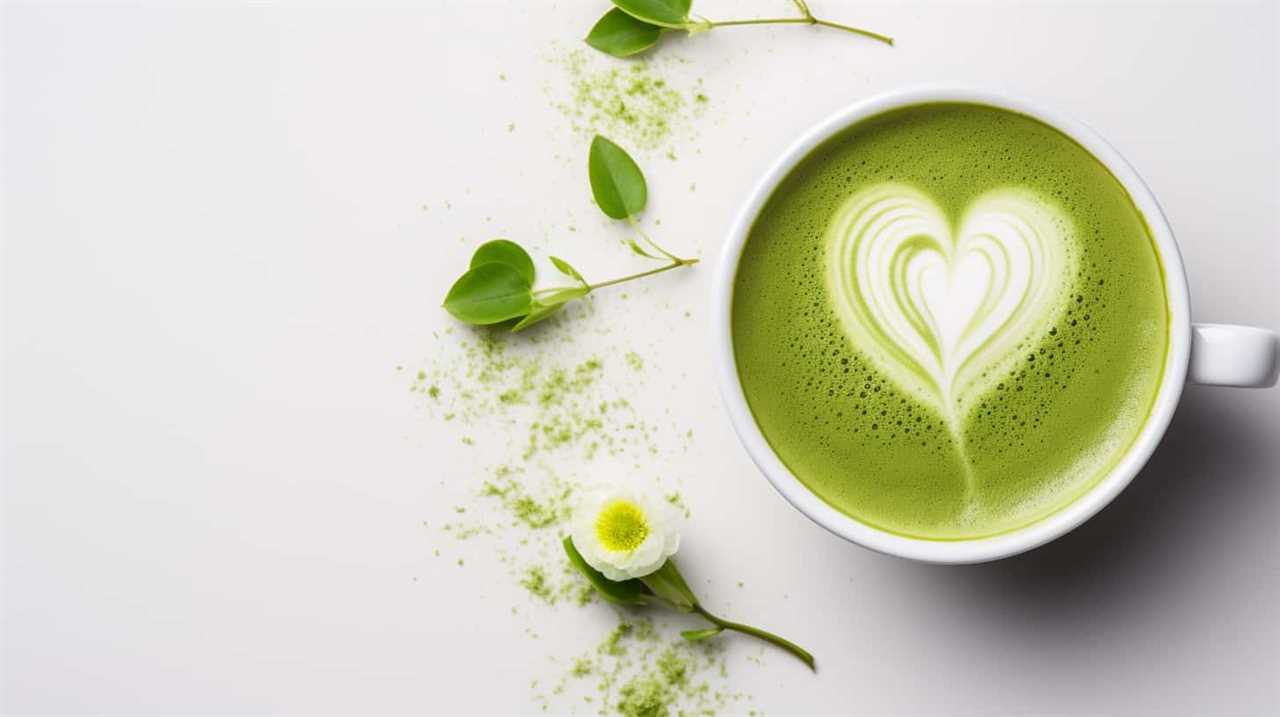
Transitioning into the next section, let’s now explore the caffeine levels in matcha and green tea.
Caffeine Levels
The caffeine levels in matcha and green tea can vary. When comparing the caffeine content of matcha and green tea, it’s important to consider several factors:
- Source: Matcha is made from shade-grown tea leaves, which increases its caffeine concentration.
- Preparation: Matcha is typically consumed in powdered form, which means you consume the entire tea leaf, resulting in higher caffeine levels compared to steeped green tea.
- Serving size: Matcha is usually consumed in smaller quantities than green tea, resulting in a lower overall caffeine intake.
- Brewing time: Green tea is steeped for a shorter duration, resulting in lower caffeine extraction compared to matcha.
- Personal tolerance: Each individual may have different sensitivities to caffeine, so effects on the body can vary.
Understanding the differences in caffeine levels between matcha and green tea is crucial for those seeking to manage their caffeine intake.
Transitioning to our next topic, let’s explore the antioxidant levels in matcha and green tea.
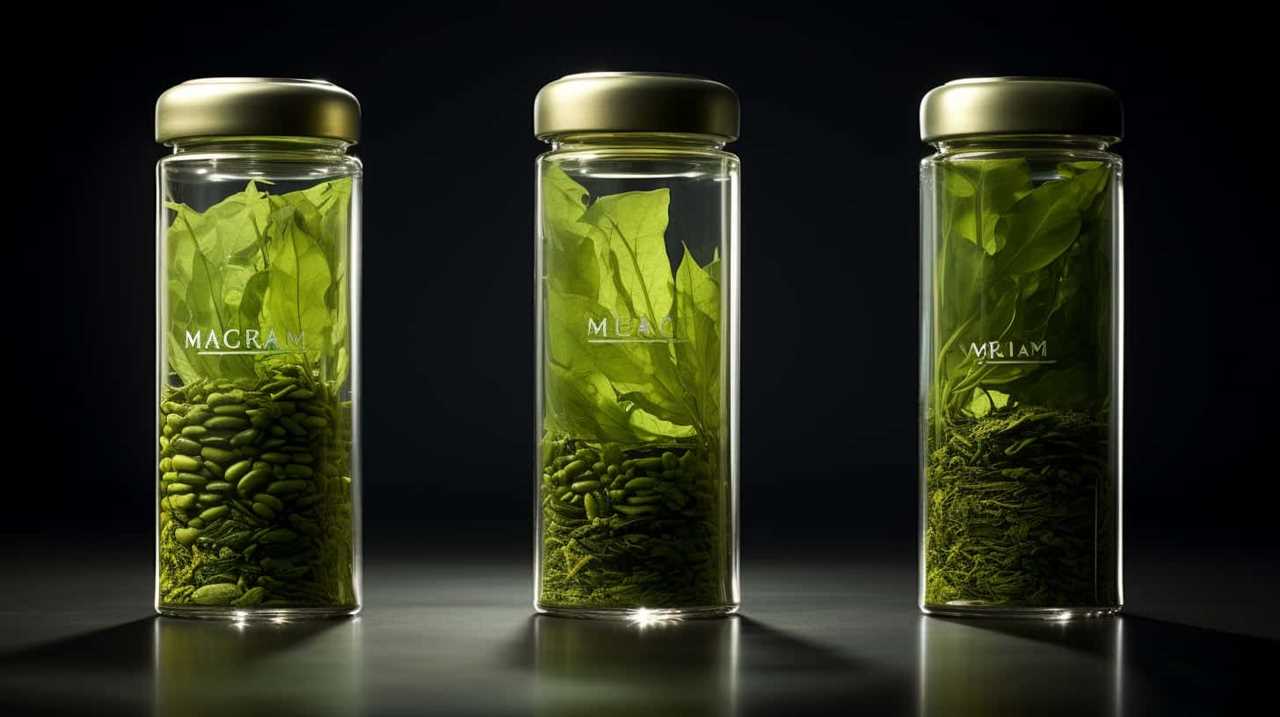
Antioxidant Levels
When comparing matcha and green tea, one important aspect to consider is their antioxidant levels. Antioxidants are compounds that help protect the body against free radicals, which can cause damage to cells and contribute to chronic diseases.
Matcha, being made from powdered whole tea leaves, contains a higher concentration of antioxidants compared to steeped green tea. This is due to the unique process of growing, harvesting, and processing matcha, which retains more of the beneficial compounds found in the leaves.
Matcha Vs. Steeped
We noticed a significant difference in the antioxidant levels between matcha and steeped green tea. When comparing the two, it becomes evident that matcha, specifically ceremonial grade matcha, surpasses steeped green tea in terms of antioxidant content.
Here are some key points to consider:

- Matcha is made from whole tea leaves that are ground into a fine powder, whereas steeped green tea involves infusing the leaves in hot water.
- The process of grinding the leaves into powder allows matcha to retain more of its antioxidants.
- Matcha contains a higher concentration of catechins, a powerful antioxidant known for its health benefits.
- The shade-grown cultivation of matcha enhances its chlorophyll content, which further contributes to its antioxidant properties.
- Studies have shown that matcha has significantly higher antioxidant activity compared to steeped green tea.
Health Benefits Comparison
One notable difference between matcha and green tea is their respective antioxidant levels. Matcha, a powdered form of green tea, is known for its high concentration of antioxidants. This is due to the unique production methods used to make matcha. The tea leaves are grown in the shade, which increases the chlorophyll content and enhances the production of antioxidants. Moreover, matcha is consumed by consuming the whole tea leaf, which ensures that all the beneficial compounds are ingested. On the other hand, green tea, which is steeped in hot water, also contains antioxidants but in lower quantities compared to matcha. The cultural significance of both matcha and green tea cannot be overlooked. Matcha has been an integral part of Japanese tea ceremonies for centuries, while green tea is deeply rooted in Asian cultures and has been enjoyed for its health benefits.
| Matcha | Green Tea | |
|---|---|---|
| Antioxidants | High | Moderate |
| Production Methods | Shade-grown, powdered | Steeped in hot water |
| Cultural Significance | Integral part of Japanese tea ceremonies | Deeply rooted in Asian cultures |
Preparation Methods
To prepare matcha and green tea, the leaves are ground into a fine powder. The preparation methods for these two types of tea differ significantly. Here are the key steps involved in steeping techniques and ceremonial preparation for both matcha and green tea:
- Matcha:
- Sift the matcha powder to remove any clumps.
- Heat water to about 175°F and pour a small amount into a bowl.
- Add the matcha powder to the bowl and whisk vigorously in a ‘W’ motion until frothy.
- Gradually add the remaining hot water while continuing to whisk.
- Enjoy the smooth and vibrant matcha tea.
- Green Tea:
- Heat water to about 175°F and pour it over the tea leaves.
- Allow the leaves to steep for 2-3 minutes.
- Strain the tea leaves and pour the brewed tea into a cup.
- Savor the delicate aroma and flavor of the green tea.
These preparation methods ensure that both matcha and green tea provide the desired taste and experience for tea enthusiasts.
Color and Appearance
When comparing matcha and green tea, the color and appearance of the two teas can be differentiated. Matcha, a vibrant powdered tea, is known for its distinct bright green color. This color variation is due to the unique way matcha is grown and processed. The tea leaves are shade-grown for several weeks before harvesting, which enhances the chlorophyll content and gives matcha its vibrant green hue.

On the other hand, green tea, in its loose leaf or tea bag form, generally has a lighter green or yellowish color. This is because green tea leaves aren’t shade-grown and undergo a different processing method. The color and appearance of matcha make it particularly appealing for ceremonial use, as it adds to the aesthetic experience of traditional tea ceremonies.
Transitioning into the next section about health benefits, let’s explore how matcha and green tea differ in terms of their nutritional properties.
Health Benefits
While both matcha and green tea offer various health benefits, it’s important to understand the differences between the two. Here are some key points to consider:
- Matcha is prepared by grinding the whole tea leaves into a fine powder, while green tea is made by steeping the leaves in hot water.
- Matcha contains higher levels of antioxidants compared to green tea, making it a potent source of health benefits.
- Scientific studies have shown that matcha can boost metabolism, improve focus and concentration, and support weight loss.
- Green tea, on the other hand, has been linked to a reduced risk of heart disease, improved brain function, and lower blood sugar levels.
- Both matcha and green tea have been found to have anti-inflammatory and anti-cancer properties, thanks to their high content of catechins.
Understanding the preparation techniques and scientific studies behind matcha and green tea can help you make an informed choice about which one suits your health goals and preferences.
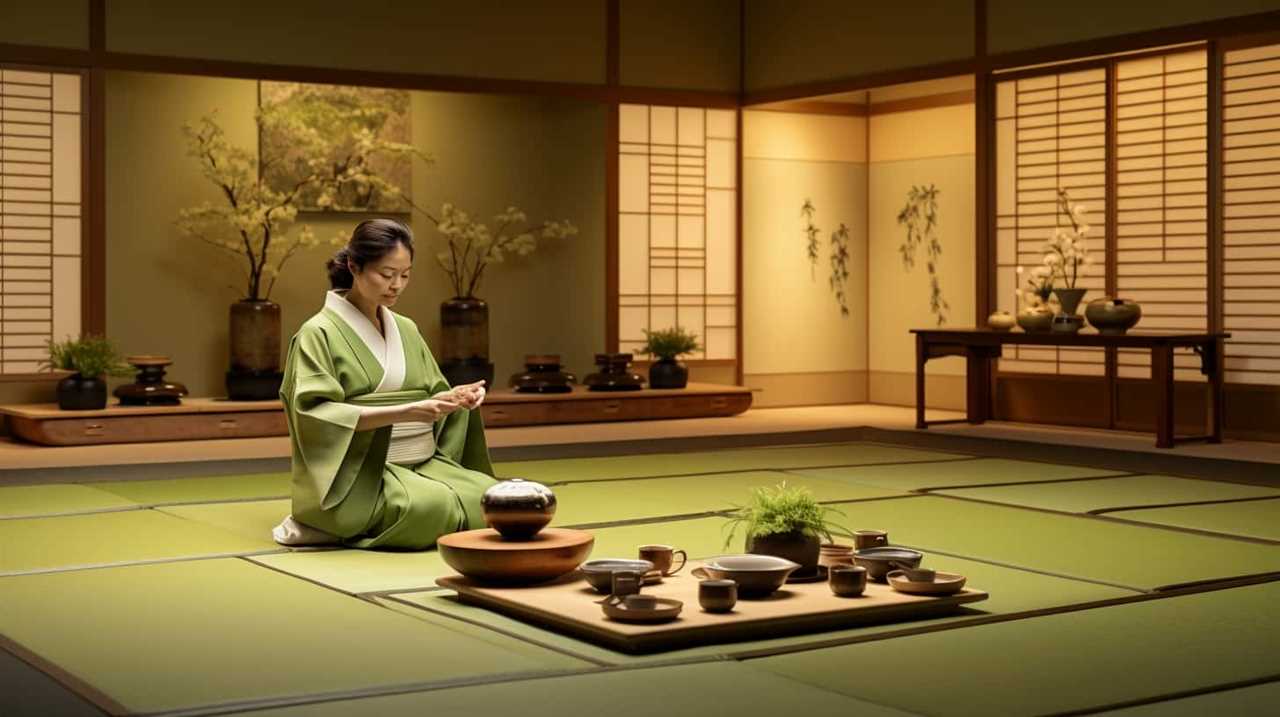
Culinary Uses
Culinary applications of matcha and green tea include infusing desserts, beverages, and savory dishes with their unique flavors and health benefits.
Matcha, with its vibrant green color and rich umami taste, is often used in traditional Japanese sweets such as matcha ice cream, matcha mochi, and matcha-flavored cakes. It can also be mixed into smoothies, lattes, and even cocktails for a refreshing and energizing twist.
Green tea, on the other hand, is commonly used as a flavoring agent in sauces and marinades for savory dishes like grilled chicken or fish. Its subtle earthy notes complement a wide range of ingredients, adding depth and complexity to the overall flavor profile.
Whether you’re looking for sweet or savory recipe ideas, both matcha and green tea offer a versatile and flavorful addition to your culinary creations.
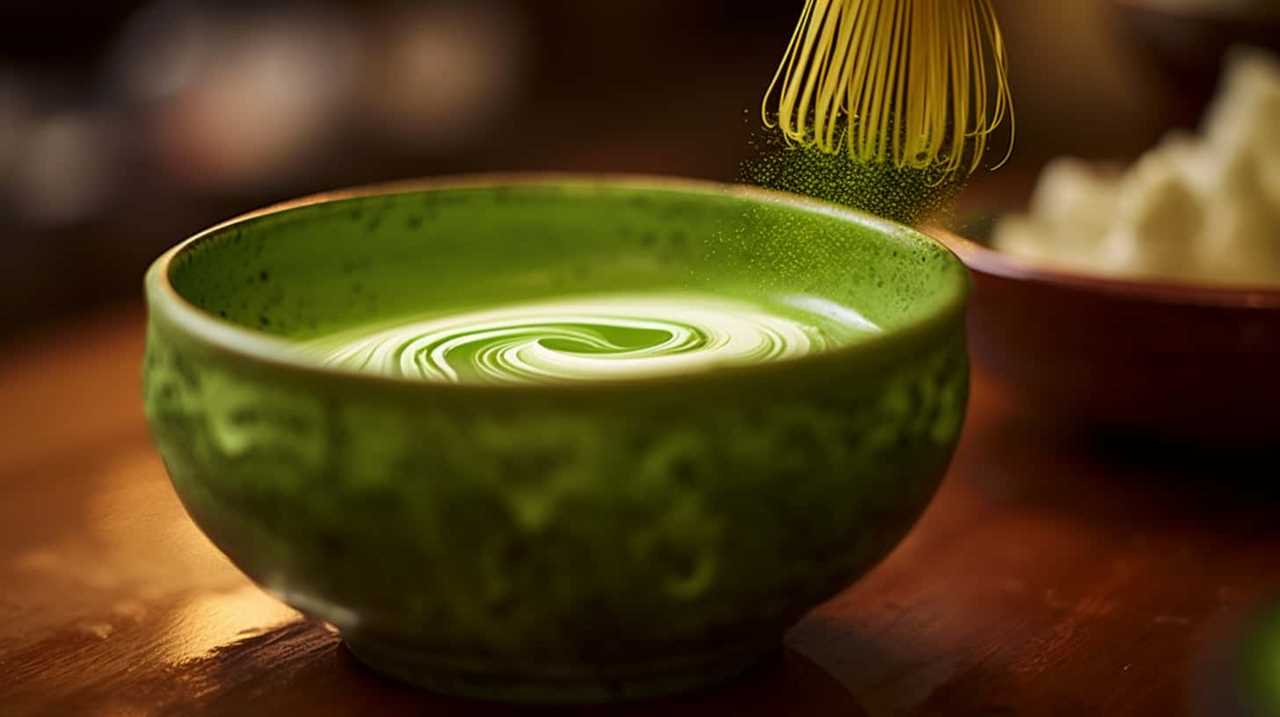
Price Comparison
In terms of cost, both matcha and green tea offer affordable options for incorporating their flavors and health benefits into your culinary creations. When comparing the prices of matcha and green tea, it’s important to consider factors such as quality, origin, and packaging. Here is a price comparison to help you evaluate your options:
- Matcha:
- Ceremonial grade matcha: $20-$30 for 30g tin
- Culinary grade matcha: $10-$20 for 100g bag
- Green tea:
- Loose leaf green tea: $5-$10 for 50g bag
- Tea bags: $3-$5 for 20 bags
While matcha tends to be slightly more expensive than green tea, the health benefits comparison is worth considering. Matcha is known for its higher concentration of antioxidants and amino acids, providing a more potent health boost compared to green tea.
Now that we’ve covered the price comparison, let’s dive into the next section on personal preference.
Personal Preference
Next, let’s explore our personal preference when it comes to choosing between matcha and green tea.

When it comes to taste comparison, both matcha and green tea offer unique flavors that cater to different palates. Matcha has a rich, creamy, and slightly bitter taste that’s distinctively different from regular green tea. Its vibrant and velvety texture provides a smooth and indulgent drinking experience.
On the other hand, green tea has a fresh, grassy, and slightly astringent taste that’s refreshing and invigorating. Some may prefer the earthy and bold flavor of matcha, while others may gravitate towards the lighter and more subtle taste of green tea.
Ultimately, personal preference plays a crucial role in determining which tea suits individual tastes and desires.
Frequently Asked Questions
Does Matcha Contain More Caffeine Than Green Tea?
Matcha and green tea differ in their caffeine content. Matcha contains higher levels of caffeine compared to green tea. The caffeine in matcha provides a more pronounced and sustained energy boost, making it a popular choice for those seeking an invigorating beverage.
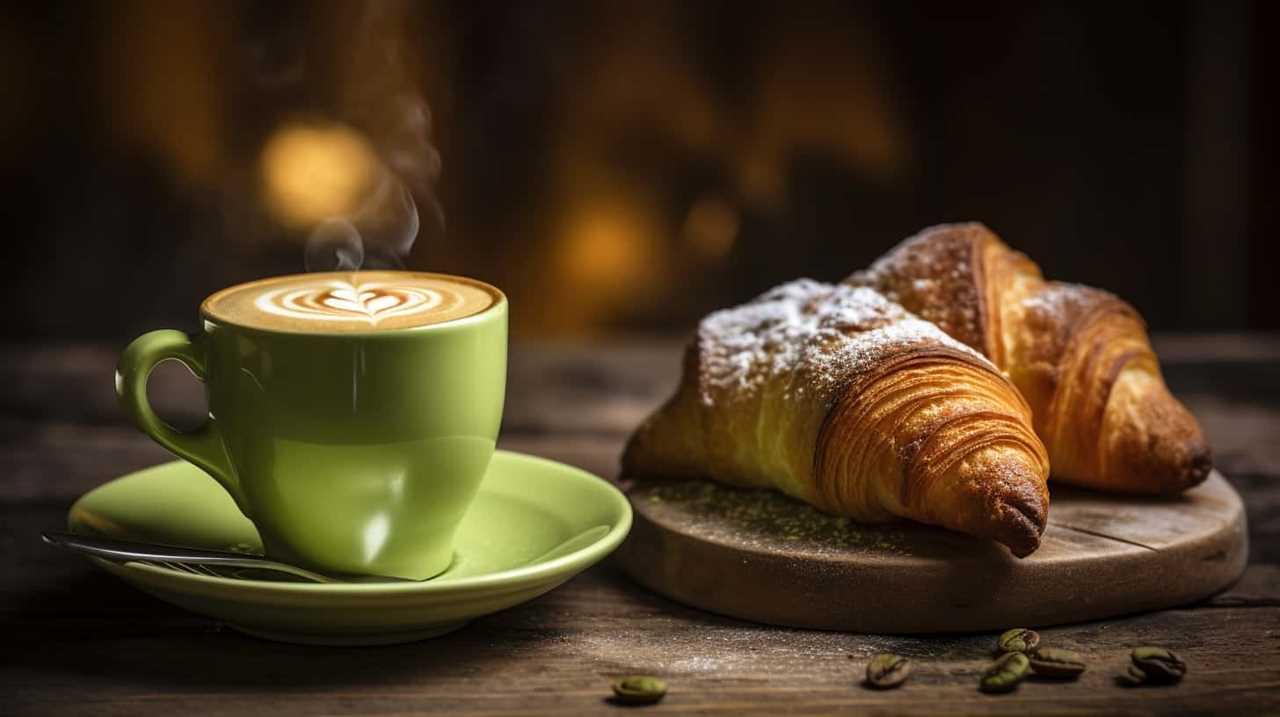
Can Matcha and Green Tea Be Used Interchangeably in Recipes?
Yes, matcha and green tea can be used interchangeably in recipes. Both offer a unique taste, but matcha has a more vibrant, earthy flavor. Experiment with different ratios to find the perfect balance for your dish.
Are There Any Potential Side Effects of Consuming Matcha or Green Tea?
There are potential side effects of consuming matcha or green tea, but they are generally mild and rare. Compared to other herbal teas, matcha and green tea offer a multitude of health benefits that make them stand out.
How Do the Health Benefits of Matcha and Green Tea Compare to Other Herbal Teas?
When comparing the health benefits of matcha and green tea to other herbal teas, it is important to consider their effects on weight loss. We will explore the differences and similarities in terms of their weight loss properties.
What Are the Differences in the Environmental Impact of Matcha and Green Tea Production?
When it comes to the environmental impact of matcha and green tea production, it’s important to consider factors such as environmental sustainability and carbon footprint. These aspects play a significant role in determining the overall sustainability of these tea production processes.

Conclusion
In conclusion, both matcha and green tea have their own unique characteristics and benefits. While green tea has a long history and is widely consumed, matcha offers a more concentrated dose of antioxidants and a vibrant flavor profile.
The choice between the two ultimately comes down to personal preference and desired health benefits. As the saying goes, ‘A cup of tea is a cup of peace,’ so sit back, relax, and enjoy the soothing and invigorating qualities of these amazing teas.
Justin is a seasoned author, coffee and tea enthusiast, and an essential member of the Cappuccino Oracle team. With a keen appreciation for the complexities of coffee, coffee alternatives, and tea, Justin has dedicated his professional career to exploring these realms and sharing his insights with readers worldwide.
Justin’s immersion in the world of coffee, coffee alternatives, and tea began at a young age, kindling a passion that extended beyond mere consumption. This love for these beverages led him to combine his talent for writing with his devotion to coffee and tea, bringing him to Cappuccino Oracle as a dedicated author.
Matcha
Unveiling The Mysteries Of Matcha: Insights On Its Origins, Production, And Quality

Have you ever been curious about the mysteries behind the rich and natural flavors of matcha? If so, get ready to join me on an adventure as we uncover the secrets of matcha, delving into its origins, production, and quality.
As a lover of all things tea, I have delved deep into the world of matcha, immersing myself in its rich history and intricate production process. From the shade-grown tea leaves to the meticulous grinding technique, every step is a labor of love that culminates in the velvety smooth powder we know as matcha.
Join me as we unravel the secrets behind this ancient Japanese tradition and discover why quality is key when indulging in this verdant elixir. We’ll explore the nuances of flavor, the importance of sourcing, and even delve into the fascinating world of other tea varieties.
So grab a cup, sit back, and let’s dive into the captivating world of matcha.
Key Takeaways
- Matcha tea is made from powdered green tea leaves and has a long and labor-intensive production process.
- Premium matcha is made from the first harvest in early spring, using the top 3 sprouts of the tea plant and ground tencha leaves.
- Cheaper matchas may skip some steps in the production process and are more suitable for matcha lattes.
- High-quality matcha is recommended for sparing consumption, as it has a smoother flavor and more health benefits compared to cheaper matchas.
What is matcha?
I’ve learned that matcha is a powdered green tea made from special tea leaves that are shaded before harvest, and it has a long and labor-intensive production process.
There are different types of matcha available, but the premium matcha is made from the first harvest in early spring, using only the top 3 sprouts of the tea plant. The leaves are then steamed, dried, and have their stems removed before being ground into a fine powder using a specialized mill made of granite.
It’s important to note that high-quality matcha is recommended for sparing consumption, as it has a complex production process that results in a smooth flavor. Matcha also offers various health benefits, such as being rich in antioxidants, boosting metabolism, and improving mental alertness.
Production process
The matcha production process involves shading the tea leaves before harvest and selecting the top three sprouts of the tea plant for premium matcha. Shading is a technique used to enhance the flavor and quality of the tea leaves. By covering the tea plants with shade, the leaves produce more chlorophyll and amino acids, resulting in a vibrant green color and a rich, umami taste.
After the shading period, only the top three sprouts of the tea plant are carefully handpicked for premium matcha. These selected leaves, known as tencha leaves, are then steamed, dried, and have their stems removed.
Finally, the tencha leaves are ground into a fine powder using a specialized granite mill. This process results in the smooth and concentrated matcha powder that we enjoy.
Quality and consumption
Let me tell you, indulging in high-quality matcha is like sipping a vibrant green elixir that awakens your taste buds and nourishes your body with its rich flavor and numerous health benefits. Matcha’s health benefits are truly remarkable. Packed with antioxidants, vitamins, and minerals, matcha is known to boost metabolism, enhance focus and concentration, and strengthen the immune system.
But not all matcha is created equal. Different grades of matcha exist, ranging from ceremonial grade to culinary grade. Ceremonial grade matcha is made from the highest quality tencha leaves and has a smooth, vibrant green color and a delicate, umami flavor. It is best enjoyed on its own, whisked with hot water.
On the other hand, culinary grade matcha is more affordable and is suitable for making matcha lattes, smoothies, and baked goods. Although it may have a slightly bitter taste and a duller color, it still provides health benefits.
So, whether you choose to indulge in high-quality ceremonial grade matcha or opt for the more affordable culinary grade, incorporating matcha into your routine is a delicious way to reap its health benefits.
Frequently Asked Questions
What are some popular ways to enjoy matcha besides drinking it as tea?
Besides drinking matcha as tea, some popular ways to enjoy it include indulging in matcha desserts like matcha ice cream, matcha cake, and matcha cookies. Additionally, matcha smoothies are a refreshing and healthy option.
Are there any specific health benefits associated with consuming matcha?
I’m no expert, but matcha is said to have potential health benefits. Some claim it can aid in weight loss due to its high antioxidant content and metabolism-boosting properties. However, more research is needed to confirm these claims.
How does the quality of matcha affect its flavor and overall experience?
The quality of matcha directly affects its flavor and overall experience. Higher quality matcha, made from carefully selected leaves and processed with precision, offers a smoother and more vibrant flavor, while lower quality matcha may have a less appealing taste and color.
Can matcha be used in cooking or baking?
"Where there’s matcha, there’s a way! Matcha can be used in a variety of cooking and baking recipes, adding a vibrant green color and a unique earthy flavor to dishes like matcha desserts."
Are there any specific tips or techniques for properly preparing matcha tea at home?
To properly prepare matcha tea at home, start by sifting the matcha powder to remove any clumps. Then, choose water at around 175°F to 180°F for the best flavor. Gradually add water to the matcha and whisk in a "W" or "M" motion until frothy. Enjoy!
Conclusion
In conclusion, matcha tea is not just a beverage, but a rich and fascinating tradition that has evolved over centuries.
From its origins in Japan to its intricate production process, matcha is a labor of love.
The quality of matcha is crucial, as the steps taken in its production directly impact its flavor and aroma.
Whether you’re a matcha connoisseur or a beginner, there is a matcha tea out there for you.
So, why not indulge in a cup of this vibrant green elixir and experience the magic of matcha for yourself? It’s a journey worth embarking on!
Arf, an author and an innovative enthusiast of coffee, coffee alternatives, and tea, plays a crucial role as a contributor to the esteemed Cappuccino Oracle platform. Renowned for his curiosity and passion for these captivating beverages, Arf has carved out a unique space for himself in the world of exploration and writing. He realized that coffee, coffee alternatives, and tea are not mere drinks to keep one awake, but universes of flavors and stories waiting to be explored.
Arf’s articles for Cappuccino Oracle blend meticulous research with personal experiences, providing readers with an in-depth understanding of various types of coffee, coffee alternatives, and tea, along with their unique characteristics, cultures, and histories. His honest reviews and engaging narratives guide readers on their own journeys, helping them discover their preferences and find their perfect brew.
Matcha
Unveiling The Truth Behind Starbucks’ Matcha: A Disappointing Blend

Being a lover of tea, I was eager to sample Starbucks’ matcha beverages, anticipating a flavorful and genuine taste. However, to my dismay, I found that it was a subpar mixture of inexpensive green tea powder and an excessive amount of sugar. This was a stark contrast to the customary matcha experience that I had grown accustomed to.
The use of low-quality matcha by Starbucks is driven by the need for mass production and a consistent taste across all locations. But in this pursuit, they have sacrificed the true essence of matcha. Authentic matcha production involves meticulous steps to ensure a high-quality and flavorful product, steps that Starbucks seems to skip.
The result is a matcha latte packed with 32 grams of sugar, equivalent to a can of soda, and a whopping 240 calories. It’s time to unveil the truth behind Starbucks’ matcha and explore better options for a truly satisfying tea experience.
Key Takeaways
- Starbucks uses a cheap green tea powder for their matcha drinks, which may not even be considered matcha.
- The cheap matcha powder is mixed with a lot of sugar, negating the health benefits and undermining the quality of the tea.
- Starbucks’ matcha latte contains a high amount of sugar, similar to a can of soda, and has a significant number of calories.
- To have a better matcha experience, it is recommended to explore premium, first harvest matcha made by talented farmers in Japan and to try different matcha options to find preferred taste.
What is Starbucks Matcha?
Starbucks Matcha is a cheap green tea powder mixed with a high amount of sugar, which not only undermines the health benefits of matcha but also fails to deliver the natural, great-tasting flavor of authentic matcha tea.
The ingredients used in Starbucks matcha include low-quality green tea powder that is likely produced on a large scale. Unlike traditional matcha production methods, Starbucks skips certain steps to save time and money. These steps, such as shading the tea plants to reduce bitterness and selecting the top leaves for their flavor and nutrients, are crucial in creating high-quality matcha.
Instead, Starbucks opts for a blend of cheap green tea powder mixed with sugar, resulting in a dull and bitter flavor. This disappointing blend of ingredients does not live up to the standards of true matcha tea.
Quality vs. Cheap Matcha
Indulging in high-quality matcha is like savoring a delicate melody that dances on your taste buds, while settling for cheap matcha is akin to a discordant symphony that leaves a bitter aftertaste. When it comes to matcha, quality matters. Traditional matcha production is an art that requires time, patience, and attention to detail. The importance of shading the tea plants, selecting the top leaves, and using a stone mill to grind the leaves into a fine powder cannot be overstated. These steps not only enhance the flavor but also preserve the health benefits of matcha. High-quality matcha is rich in antioxidants, boosts metabolism, and promotes a sense of calm. On the other hand, cheap matcha often lacks these qualities as it skips crucial steps and is mixed with sugar and other additives. Don’t settle for a subpar matcha experience; choose high-quality matcha for its exceptional taste and health benefits.
| Traditional Matcha Production |
|---|
| Shading the tea plants |
| Selecting the top leaves |
| Grinding with a stone mill |
The importance of traditional matcha production cannot be overstated. These steps not only enhance the flavor but also preserve the health benefits of matcha. High-quality matcha is rich in antioxidants, boosts metabolism, and promotes a sense of calm. On the other hand, cheap matcha often lacks these qualities as it skips crucial steps and is mixed with sugar and other additives. Don’t settle for a subpar matcha experience; choose high-quality matcha for its exceptional taste and health benefits.
Recommendations for Better Matcha
Exploring different matcha options can lead to a better matcha experience. When it comes to matcha, not all options are created equal. While Starbucks may offer a convenient matcha latte, there are alternative options that provide a more authentic and higher quality experience.
Premium matcha, specifically first harvest matcha, is made by talented farmers in Japan and can be enjoyed plain, without the need for excessive sugar or additives. By choosing premium matcha, you can reap the full benefits that matcha has to offer, such as its high antioxidant content and potential health benefits.
Additionally, exploring different types of matcha, such as Japanese black tea, can expand your taste palate and introduce you to new and exciting flavors. So, why settle for a disappointing blend when there are better matcha options out there waiting to be explored?
Frequently Asked Questions
How is Starbucks matcha different from traditional matcha?
Starbucks matcha differs from traditional matcha in terms of quality and taste. One interesting statistic is that Starbucks’ matcha latte contains 32 grams of sugar, similar to a can of soda, which undermines the health benefits of matcha.
What are the health benefits of matcha and how do they differ between Starbucks matcha and premium matcha?
The health benefits of matcha include high levels of antioxidants, increased energy, and improved focus. However, Starbucks matcha quality is compromised due to the use of cheap powder mixed with sugar, negating these benefits.
Can you customize the sweetness level of Starbucks matcha drinks?
Yes, you can customize the sweetness level of Starbucks matcha drinks. They offer popular matcha drink variations like matcha latte and matcha frappuccino, allowing customers to choose the amount of sweetener they prefer.
Are there any alternative options for matcha drinks at Starbucks?
Yes, there are alternative options for matcha drinks at Starbucks. However, it’s important to note that the taste may not be comparable to traditional matcha. Exploring different matcha options and Japanese black tea can provide a better experience.
What are the steps involved in producing high-quality matcha and how does Starbucks’ matcha production differ?
Starbucks’ matcha production process differs from traditional matcha production in Japan. High-quality matcha involves shading the tea plants, selecting the top leaves, steaming, drying, and grinding them. However, Starbucks skips these steps, resulting in a lower quality and less authentic matcha experience.
Conclusion
In conclusion, after delving into the truth behind Starbucks’ matcha, it’s clear that their blend falls short of expectations. The use of cheap green tea powder mixed with excessive sugar dilutes any potential health benefits and fails to deliver an authentic matcha experience.
To truly enjoy the rich and flavorful taste of matcha, it’s recommended to explore premium, first harvest options crafted by skilled Japanese farmers. Don’t settle for subpar matcha; treat yourself to a tea experience that’ll leave your taste buds dancing with delight.
Arf, an author and an innovative enthusiast of coffee, coffee alternatives, and tea, plays a crucial role as a contributor to the esteemed Cappuccino Oracle platform. Renowned for his curiosity and passion for these captivating beverages, Arf has carved out a unique space for himself in the world of exploration and writing. He realized that coffee, coffee alternatives, and tea are not mere drinks to keep one awake, but universes of flavors and stories waiting to be explored.
Arf’s articles for Cappuccino Oracle blend meticulous research with personal experiences, providing readers with an in-depth understanding of various types of coffee, coffee alternatives, and tea, along with their unique characteristics, cultures, and histories. His honest reviews and engaging narratives guide readers on their own journeys, helping them discover their preferences and find their perfect brew.
Matcha
The Ultimate Guide To Using Chashaku: Your Matcha Essential

Being a lover of matcha, I am aware that the crucial factor in achieving the perfect matcha bowl is the equipment we utilize. When it comes to preparing matcha, there is one tool that is particularly essential: the chashaku.
This bamboo spoon, with its elegant design and precise measurements, is the secret weapon of matcha lovers worldwide. In this ultimate guide, I will take you on a journey through the history and evolution of the chashaku, and show you how to use it like a pro.
From its origins as a metal or ivory scoop to its modern-day incarnation in bamboo, the chashaku has come a long way. With its 48° bend and 18mm length, it effortlessly scoops the perfect amount of matcha from its container.
So grab your chashaku and get ready to elevate your matcha game to new heights. Let’s dive in and discover the wonders of this matcha essential.
Key Takeaways
- Chashaku is a bamboo spoon used to scoop matcha powder in the Japanese tea ceremony and by matcha lovers worldwide.
- Chashaku is one of the three important tea utensils used in the tea ceremony and is about 18mm in length with a 48° bend at the end for scooping.
- Chashaku is made of bamboo to avoid negative reactions with matcha powder and is a great measurement tool for matcha powder.
- Two scoops of chashaku is the standard amount for a bowl of matcha tea, and it is easy to maneuver in matcha tins or natsume due to its small size.
What is Chashaku?
Chashaku is a bamboo spoon used to scoop matcha powder, and it’s one of the three important tea utensils used in the Japanese tea ceremony.
Made from a single piece of bamboo, this elegant tool has a long history dating back to the Muromachi period in Japan. Originally crafted from metal or ivory, chashaku evolved to be made of bamboo due to its natural properties and to avoid any negative reactions with matcha powder.
The design of chashaku is both functional and beautiful, with a length of about 18mm and a 48° bend at the end for easy scooping. There are different styles of chashaku scoops, each with its own unique shape and characteristics. The back of the chashaku has a rough texture, while the face is smooth and sleek.
Whether you’re a matcha lover or a tea ceremony enthusiast, using a chashaku adds a touch of authenticity and tradition to your matcha preparation.
History and Evolution
During the Muromachi period in Japan, the chashaku spoon evolved from being made of metal or ivory to its current bamboo form, which is about 18mm in length and has a 48° bend at the end for easier scooping. The history and evolution of the chashaku is a testament to its significance in Japanese tea ceremonies and its cultural importance in matcha preparation.
| The significance of chashaku in Japanese tea ceremonies | The cultural importance of chashaku in matcha preparation |
|---|---|
| Chashaku is one of the three important tea utensils used in the tea ceremony. | Chashaku is a great measurement tool for matcha powder. |
| Chashaku originated in Japan during the Muromachi period. | Chashaku’s small size allows for easy maneuvering in matcha tins or natsume. |
| Originally made of metal or ivory, chashaku evolved to be made of bamboo. | Chashaku is made from a single piece of bamboo and shaped with a bend for the scoop. |
| Chashaku is made of bamboo to avoid negative reactions with matcha powder. | The back of chashaku has a rough texture, while the face is smooth and sleek. |
The chashaku’s role in Japanese tea ceremonies cannot be understated. It is one of the three essential utensils used in the tea ceremony, alongside the chawan (tea bowl) and chasen (tea whisk). The chashaku’s small size and precise measurement make it the perfect tool for scooping matcha powder. Its evolution from metal or ivory to bamboo shows the cultural importance placed on this utensil. The chashaku’s design, with its gentle bend and smooth face, allows for easy and graceful scooping of matcha. Using the chashaku is not only practical but also a way to honor the centuries-old tradition of matcha preparation.
How to Use Chashaku
To use the chashaku, I simply hold it like a pencil and dip the scoop into the matcha container. Then, I carefully lift the chashaku scoop out and place it over the matcha bowl to dump the powder.
It’s a simple and elegant technique that ensures the perfect amount of matcha every time.
But did you know that there are alternative ways to use the chashaku? Some matcha lovers prefer to use a teaspoon or a regular spoon to scoop their matcha powder. While these alternatives may work in a pinch, they don’t offer the same precision and authenticity as the chashaku.
The chashaku’s unique design and size make it the ideal tool for measuring matcha powder. Plus, using the chashaku adds a traditional touch to the matcha preparation process, enhancing the overall experience.
So why settle for anything less? Embrace the chashaku and elevate your matcha game to the next level.
Frequently Asked Questions
What are the different types of materials used to make chashaku besides bamboo?
There’s something truly magical about the chashaku, the bamboo spoon that gracefully scoops matcha powder. While bamboo is the traditional material, chashaku can also be made from metal or ivory, although these alternatives are less common.
Can chashaku be used to scoop other powders besides matcha?
Yes, chashaku can be used to scoop other powders besides matcha. However, it is primarily designed for scooping matcha powder and is most commonly used in Japanese tea ceremonies. To properly clean and care for a chashaku, it is recommended to wipe it with a dry towel or tissue to avoid water damage. The chashaku is a versatile tool with different uses in the tea ceremony, making it an essential item for matcha lovers.
How long does a chashaku typically last before it needs to be replaced?
A chashaku typically lasts for a long time, but the lifespan can vary depending on the material. Bamboo chashaku is the most common and durable option, while metal or ivory may wear down over time. Proper care involves cleaning with a dry towel or tissue to avoid water damage.
Can chashaku be used with different types of matcha bowls or is it specific to a certain style?
Absolutely! Chashaku can be used with various types of matcha bowls, adapting to different styles. Its small size and unique design make it perfect for scooping matcha powder and adding a touch of elegance to your matcha preparation.
Are there any alternative utensils that can be used in place of chashaku for scooping matcha powder?
Yes, there are alternative utensils for scooping matcha powder, such as a teaspoon or a small spoon. However, using a chashaku has its benefits. Its unique design allows for precise measurements and easy maneuvering in matcha tins.
Conclusion
In conclusion, using chashaku isn’t just a practical way to measure and scoop matcha powder, but it’s also an essential tool for embracing the art and tradition of the Japanese tea ceremony.
While some may argue that using a regular spoon can achieve the same result, chashaku offers a unique experience that connects us to centuries of tea culture. Imagine holding the slender bamboo spoon, feeling the weight of tradition in your hand, and delicately scooping the vibrant green matcha powder.
It’s a sensory journey that brings us closer to the beauty and mindfulness of matcha preparation. So, embrace the chashaku, and let it elevate your matcha experience to new heights.
Arf, an author and an innovative enthusiast of coffee, coffee alternatives, and tea, plays a crucial role as a contributor to the esteemed Cappuccino Oracle platform. Renowned for his curiosity and passion for these captivating beverages, Arf has carved out a unique space for himself in the world of exploration and writing. He realized that coffee, coffee alternatives, and tea are not mere drinks to keep one awake, but universes of flavors and stories waiting to be explored.
Arf’s articles for Cappuccino Oracle blend meticulous research with personal experiences, providing readers with an in-depth understanding of various types of coffee, coffee alternatives, and tea, along with their unique characteristics, cultures, and histories. His honest reviews and engaging narratives guide readers on their own journeys, helping them discover their preferences and find their perfect brew.
-

 Americano3 weeks ago
Americano3 weeks agoHow to Make Americano With Moka Pot
-

 Americano4 weeks ago
Americano4 weeks agoHow to Make an Americano in a French Press
-

 Americano6 days ago
Americano6 days agoHow to Make Korean Iced Americano
-

 Americano3 weeks ago
Americano3 weeks agoHow to Make Iced Americano With Instant Coffee
-

 Americano3 weeks ago
Americano3 weeks agoWhat to Add to an Americano at Starbucks
-

 Americano4 weeks ago
Americano4 weeks agoHow to Make Americano With a Nespresso Machine
-

 Americano3 weeks ago
Americano3 weeks agoHow to Make Americano With Bialetti
-

 Americano3 weeks ago
Americano3 weeks agoHow to Make Dutch Bros Americano

















